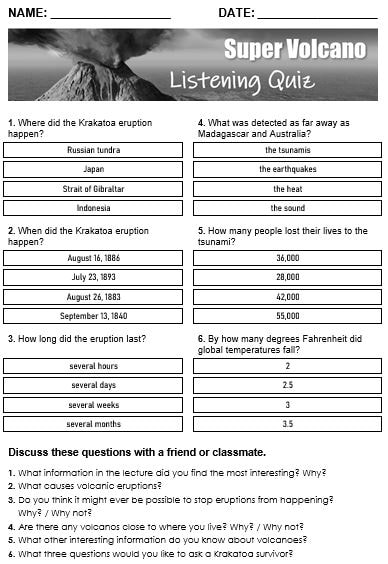Free printable PDF lesson plans, word banks, quizzes and games for EFL/ESL teachers
ADVANCED LISTENING PRACTICE
SUPER VOLCANO
SUPER VOLCANO
Audio Script
The Krakatoa volcanic eruption of 1883 was one of the most catastrophic and deadly volcanic eruptions in recorded history. Located in the Sunda Strait, between the Indonesian islands of Java and Sumatra, the eruption of Krakatoa not only caused widespread devastation to the surrounding area, it also had a massive impact on our planet's climate.
The eruption began on August 26, 1883, and lasted for several days. It started with a series of explosive eruptions that hurled ash and rock thousands of meters into the air. The force of the eruption was so great that it created massive tsunamis which swept across the strait and caused widespread destruction along the coast.
One of the most notable impacts of the Krakatoa eruption was the sound it produced. The explosive release of gas and ash created a series of shockwaves that traveled around the world multiple times. It produced a loud booming sound that could be heard as far away as Madagascar and Australia. The sound was so loud that it was recorded in ship logbooks and newspaper reports, and it remains one of the loudest sounds ever recorded in human history.
The aftermath of the Krakatoa eruption was equally devastating. In addition to the tsunamis, which caused widespread damage and loss of 36,000 lives, the ash clouds produced by the eruption rose into the upper atmosphere and reflected sunlight and cooled the earth's surface. This led to a decrease of three degrees Fahrenheit in global temperatures.
Despite its devastating effects, however, the Krakatoa super volcano eruption also provided an opportunity for scientific research. The eruption was extensively studied by scientists, who used it to better understand the processes of volcanic eruptions and their impacts on the environment.
The Krakatoa volcanic eruption of 1883 was one of the most catastrophic and deadly volcanic eruptions in recorded history. Located in the Sunda Strait, between the Indonesian islands of Java and Sumatra, the eruption of Krakatoa not only caused widespread devastation to the surrounding area, it also had a massive impact on our planet's climate.
The eruption began on August 26, 1883, and lasted for several days. It started with a series of explosive eruptions that hurled ash and rock thousands of meters into the air. The force of the eruption was so great that it created massive tsunamis which swept across the strait and caused widespread destruction along the coast.
One of the most notable impacts of the Krakatoa eruption was the sound it produced. The explosive release of gas and ash created a series of shockwaves that traveled around the world multiple times. It produced a loud booming sound that could be heard as far away as Madagascar and Australia. The sound was so loud that it was recorded in ship logbooks and newspaper reports, and it remains one of the loudest sounds ever recorded in human history.
The aftermath of the Krakatoa eruption was equally devastating. In addition to the tsunamis, which caused widespread damage and loss of 36,000 lives, the ash clouds produced by the eruption rose into the upper atmosphere and reflected sunlight and cooled the earth's surface. This led to a decrease of three degrees Fahrenheit in global temperatures.
Despite its devastating effects, however, the Krakatoa super volcano eruption also provided an opportunity for scientific research. The eruption was extensively studied by scientists, who used it to better understand the processes of volcanic eruptions and their impacts on the environment.















